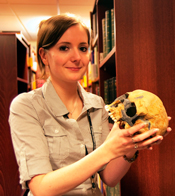Dr Heather Bonney
The information stored in bones inspires our forensic anthropology expert to tell the stories of skeletons.

Early aspirations
During her undergraduate degree in forensic science, Dr Bonney worked on a medieval cemetery that had been discovered in a cellar, helping to remove and catalogue the remains of 80 people.
‘I realised you could tell whole stories about people from their skeletons, even 800 years after they died,’ says Dr Bonney. For example, because it was evident that the teeth were not rotten, it suggests these people had very little sugar in their diets.
Dr Bonney now uses her expertise to look after our human remains collections and for forensic science research.
Handling human remains
Documenting archaeological human remains, by measuring and scanning them, makes the data available for study without the actual remains needing to be handled. Creating digital collections also means scientist can ask for ‘virtual’ loans of data without physically having to visit the Museum.
Dr Bonney also works on trauma studies, looking into the characteristics of injuries on bones. Her PhD thesis focussed on the usefulness of pig carcasses as substitutes for human cadavers in trauma studies, and found that the behaviour of the bones differed significantly.
Examples of trauma in the collections can help inform modern forensic work, but most often Dr Bonney is called to help identify human remains when they are found unexpectedly. First, she determines whether the bones are animal or human, archaeological or modern, and then looks for any identifying characteristics, including sex, age, height and ancestry.
Bringing the past to life
London has been a bustling metropolis for centuries, so fresh mysteries are often uncovered. Bones, both animal and human, wash from Thames on a regular basis as they erode out of the river banks.
There are also mysteries closer to home – Dr Bonney has an actual skeleton in her office closet. Its original source is unknown, but it dates from the Victorian era.